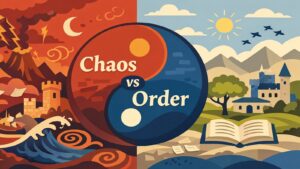Table of Contents
Introduction: The Psychology of Suspense in Storytelling

Alfred Hitchcock once demonstrated the difference between suspense and surprise with a simple example. Surprise happens when a bomb explodes unexpectedly under a dinner table. Suspense occurs when the audience knows the bomb exists and watches the clock tick toward detonation while characters remain unaware. This distinction reveals why suspense stands as one of storytelling’s most powerful psychological tools.
Suspense operates through time manipulation rather than shock value. It transforms passive readers into active participants who lean forward, hold their breath, and feel their hearts race. The master storyteller understands that suspense emerges from the tension between knowledge and ignorance, certainty and uncertainty. This psychological phenomenon taps into our fundamental human need to resolve uncertainty and complete patterns.
Great storytellers across cultures and centuries have discovered that time serves as their most potent weapon in creating suspense. They stretch moments of tension, compress periods of action, and manipulate temporal perception to keep audiences emotionally invested. From Homer’s Odyssey to modern thrillers, successful narratives employ sophisticated time tricks that amplify psychological tension.
The six proven techniques explored in this article represent centuries of refined storytelling wisdom. These methods work because they align with how our minds process time and anticipation. Each technique operates on different temporal levels, from external deadlines to internal psychological clocks. Understanding these approaches allows storytellers to create experiences that linger in memory long after the final page.
Modern neuroscience validates what storytellers have known intuitively. Our brains respond to narrative tension by releasing stress hormones and heightening attention. This biological response creates the addictive quality that makes suspenseful stories impossible to put down. The following techniques harness this natural response through deliberate time manipulation.
Storytelling Psychology Techniques: Comparative Analysis
| Storytelling Psychologies | Core Mechanism | Reader Engagement | Information Control | Emotional Impact | Success Metric |
|---|---|---|---|---|---|
| Suspense | Anticipation anxiety; withholding resolution | “What happens next?” – forward tension | Selective revelation with tantalizing clues | Anxiety, tension, relief cycles | Page-turning compulsion |
| Mirror Effect | Empathy through character identification | “I see myself in this” – personal connection | Reveals relatable human experiences | Emotional validation, connection | Strong character attachment |
| Emotional Arc | Guided emotional journey with cathartic peaks | “I feel what the story intends” – emotional flow | Controls pacing of emotional reveals | Planned emotional experience | Feeling moved or changed |
| Narrative Hook | Immediate attention capture through intrigue | “I must know more” – curiosity activation | Intriguing glimpse promising larger story | Excitement, curiosity pull | Continued reading past opening |
| World Immersion | Presence illusion through detailed consistency | “I am there” – environmental engagement | Rich, believable world-building details | Wonder, belonging, presence | Vivid mental imagery |
| Twist | Cognitive surprise requiring reinterpretation | “Everything I knew was wrong” – paradigm shift | Conceals crucial info while misdirecting | Shock, revelation, understanding | Desire to reread with new knowledge |
1. Suspense and the Countdown Clock: Tension That Never Stops
The countdown clock embodies suspense in its most authentic state. When readers know that something significant must happen within a specific timeframe, every passing moment carries weight. This technique transforms time from an abstract concept into a tangible antagonist that creates mounting pressure. The clock becomes a character that never rests, never negotiates, and never shows mercy.
Narratology reveals how countdown structures function as organizing principles that guide both plot development and reader engagement. The ticking clock creates what theorists call “temporal scaffolding” that supports narrative tension. This framework allows storytellers to build anticipation systematically while providing clear parameters for resolution. The countdown serves as both constraint and catalyst, forcing action while maintaining focus.
Real-world countdown scenarios demonstrate this technique’s effectiveness across genres. In spy thrillers, protagonists race against nuclear detonation timers. Romance novels feature characters rushing to prevent unwanted marriages or catch departing lovers. Horror stories use countdowns to amplify fear as monsters approach or curses activate. Each application leverages our instinctive response to approaching deadlines.
The psychological power of countdowns stems from their intersection with human temporal perception. Our minds naturally segment time into manageable units, and countdown clocks exploit this tendency by making each segment meaningful. The technique works because it mirrors real-life pressure situations where time scarcity increases emotional intensity. Wedding planners, emergency responders, and athletes all understand how deadlines transform routine activities into high-stakes events.
Effective countdown implementation requires careful calibration. Too much time reduces urgency, while insufficient time prevents proper tension development. Master storytellers often layer multiple countdowns with different time scales. A character might face an immediate physical threat while simultaneously racing against a larger deadline. This layering creates complex rhythms that prevent monotony while maintaining pressure.
Narratological Functions of Countdown Techniques
| Function | Narrative Purpose | Reader Response |
|---|---|---|
| Plot Acceleration | Drives story momentum | Increased reading speed |
| Character Revelation | Forces decisive action | Deeper character understanding |
| Tension Maintenance | Sustains engagement | Continued attention focus |
| Resolution Framework | Provides natural endpoints | Satisfying closure anticipation |
| Pacing Control | Regulates story rhythm | Emotional synchronization |
2. Suspense Through Delayed Outcomes: Keeping Audiences Waiting

Delayed outcomes transform setup and payoff into an art form that stretches emotional investment across extended narrative time. This technique operates on the principle that anticipation often exceeds realization in terms of psychological impact. By extending the gap between promise and delivery, storytellers create sustained tension that keeps readers engaged through multiple scenes, chapters, or even entire volumes.
The delayed outcome strategy works by establishing clear expectations early in the narrative, then systematically postponing resolution while adding complications. Shakespeare mastered this approach in his comedies, where romantic unions face obstacle after obstacle before final resolution. Modern television series employ the same principle, stretching character arcs across multiple seasons while providing partial satisfactions that maintain hope without eliminating uncertainty.
Psychological research supports the effectiveness of delayed gratification in narrative contexts. The human brain releases dopamine not just when rewards arrive, but also during anticipation periods. This neurochemical response explains why readers continue engaging with stories even when outcomes remain uncertain. The delay itself becomes pleasurable when properly managed, creating addiction-like engagement patterns.
Successful delay requires strategic pacing that maintains momentum without frustrating readers. Writers achieve this balance by providing intermediate revelations that advance understanding without resolving central questions. Each small revelation reshapes expectations while preserving core uncertainties. This technique resembles a striptease where each revealed detail heightens desire for complete exposure.
The danger in delayed outcomes lies in overstretching reader patience. Excessive delays without meaningful development can transform suspense into annoyance. Effective practitioners provide enough forward movement to justify continued investment while preserving the central mystery. They understand that delay must serve story rather than simply extending page count.
Delayed Outcome Implementation Strategies
| Strategy | Purpose | Application |
|---|---|---|
| Incremental Revelation | Maintains engagement | Gradual clue distribution |
| False Resolutions | Resets expectations | Temporary satisfaction followed by new complications |
| Parallel Delays | Multiplies tension | Multiple unresolved storylines |
| Contextual Expansion | Deepens complexity | Additional background that complicates resolution |
| Character Perspective Shifts | Delays information transfer | Different viewpoints reveal partial truths |
3. Suspense and Anticipation: A Reader-Response Theory Lens
Reader-Response Theory illuminates how audiences actively participate in creating suspense through their own psychological engagement with narrative uncertainty. This theoretical framework recognizes that readers bring personal experiences, cultural knowledge, and emotional histories to every story encounter. Suspense emerges not just from textual elements but from the dynamic interaction between story and reader consciousness.
The theory reveals how readers co-create suspense by filling narrative gaps with their own speculations and fears. When storytellers withhold information, readers automatically generate possibilities based on genre conventions, character psychology, and plot logic. This mental activity transforms passive consumption into active participation where readers become collaborative partners in tension creation. The most effective suspense stories provide enough information to guide speculation without dictating specific outcomes.
Anticipation operates through what reader-response theorists call “interpretive communities” where shared cultural knowledge shapes expectations. Horror readers anticipate different outcomes than romance readers when characters enter dark houses. These genre-specific expectations allow storytellers to subvert or fulfill anticipations strategically. The interplay between expected and unexpected outcomes creates sophisticated suspense patterns that reward genre literacy while remaining accessible to newcomers.
Individual reader psychology also influences suspense effectiveness. Personal phobias, traumatic experiences, and emotional sensitivities shape how different readers respond to identical narrative elements. A story featuring enclosed spaces affects claustrophobic readers differently than those without spatial anxieties. Skilled storytellers incorporate universal fears alongside specific triggers to create broad appeal while maintaining individual impact.
The temporal dimension of reader response reveals how anticipation builds through accumulated reading experience. Each page turn represents a small act of faith that investment will yield satisfaction. Suspense stories exploit this reading contract by extending the period between investment and return. Readers continue because they have already committed time and emotional energy that abandonment would waste.
Reader-Response Elements in Suspense Creation
| Element | Reader Activity | Suspense Effect |
|---|---|---|
| Gap Filling | Mental speculation | Active engagement |
| Genre Recognition | Expectation formation | Predictable yet surprising outcomes |
| Cultural Interpretation | Meaning construction | Personalized tension experience |
| Emotional Investment | Psychological commitment | Continued reading motivation |
| Pattern Recognition | Narrative prediction | Satisfying resolution anticipation |
4. Suspense in Pacing: Playing with Speed and Silence

Pacing manipulation creates suspense through deliberate rhythm variation that mirrors human emotional states during stress. Like a musical composition that alternates between rapid passages and sustained notes, effective storytelling adjusts tempo to match and enhance narrative tension. This technique recognizes that readers’ psychological states synchronize with story rhythm, creating opportunities to amplify emotional impact through temporal control.
Rapid pacing during action sequences mirrors physiological arousal patterns where heart rates accelerate and breathing quickens. Concise sentences, dynamic verbs, and shortened time frames evoke similar stress reactions in readers. Conversely, slow pacing during tense moments allows anxiety to build gradually, like pressure accumulating in a sealed container. This deliberate deceleration forces readers to experience uncertainty for extended periods, intensifying eventual release.
Silence serves as pacing’s most powerful tool, creating spaces where readers’ imaginations fill voids with their own fears and expectations. These narrative pauses function like musical rests that make surrounding notes more impactful. Horror writers excel at using silence to build dread, describing characters listening to unexplained sounds or waiting in darkness. The absence of information becomes more frightening than explicit description.
Genre requirements influence pacing choices while suspense principles remain constant. Thriller writers typically favor rapid alternation between fast and slow sections, creating roller-coaster experiences that prevent emotional adaptation. Literary fiction might employ more subtle pacing shifts that reflect character psychology rather than external events. Mystery novels often slow during investigation scenes while accelerating during revelation sequences.
Effective pacing requires understanding reader fatigue and recovery cycles. Sustained high tension exhausts audiences while extended slow periods risk losing attention. Master storytellers create pacing patterns that provide relief without eliminating tension entirely. They understand that contrast enhances impact, making quiet moments more peaceful and intense moments more overwhelming.
Pacing Techniques Across Different Genres
| Genre | Fast Pacing Application | Slow Pacing Application |
|---|---|---|
| Thriller | Chase sequences and confrontations | Character reflection and planning |
| Horror | Monster encounters and escapes | Atmosphere building and dread creation |
| Mystery | Discovery and revelation scenes | Investigation and deduction processes |
| Romance | Emotional climaxes and confessions | Character development and internal conflict |
| Adventure | Action sequences and dangers | World building and relationship development |
5. Suspense and Binary Opposites: A Structuralist Framework
Structuralism demonstrates how suspense flourishes through binary oppositions that establish distinct stakes and significant choices. This theoretical framework demonstrates that narrative tension emerges from fundamental dualities such as life versus death, success versus failure, and love versus loss. These oppositions provide cognitive frameworks that help readers understand what characters risk and what they might gain, making emotional investment possible.
The power of binary thinking stems from human cognitive architecture that processes information through comparative analysis. When storytellers present clear opposites, readers automatically understand consequences and begin emotional preparation for outcomes. This psychological tendency explains why simple conflicts often generate more suspense than complex situations with ambiguous stakes. The clarity of opposition allows maximum focus on uncertainty of resolution.
Prolonged uncertainty between opposing outcomes creates what structuralists call “suspended resolution” where narrative energy accumulates without discharge. This suspension requires careful management to prevent reader frustration while building maximum tension. Effective practitioners introduce obstacles that prevent immediate resolution while maintaining plausible paths toward either outcome. Each development reshuffles probability without eliminating alternative possibilities.
Cultural variations in binary thinking influence how different audiences respond to oppositional structures. Western storytelling techniques often emphasize individual versus society conflicts, while Eastern storytelling traditions might focus on harmony versus discord themes. Understanding these cultural frameworks helps storytellers craft oppositions that resonate with target audiences while maintaining universal appeal through fundamental human experiences.
Time manipulation within binary structures involves extending moments of choice where characters must decide between opposing paths. These decision points become pressure cookers where accumulated tension demands release through action. The more prolonged the characters’ hesitation between options, the more intense the suspense grows. This technique works because readers experience vicarious decision stress while anticipating consequences.
Binary Oppositions in Suspense Narratives
| Opposition Type | Narrative Function | Reader Engagement |
|---|---|---|
| Life vs Death | Ultimate stakes creation | Maximum emotional investment |
| Success vs Failure | Goal-oriented tension | Achievement anxiety simulation |
| Truth vs Deception | Information uncertainty | Knowledge-seeking motivation |
| Freedom vs Captivity | Agency-based conflict | Empowerment desire activation |
| Love vs Isolation | Relationship stakes | Connection need stimulation |
6. Suspense in Psychological Time: The Inner Ticking Clock
Psychological time creates suspense through internal character experiences that operate independently of external chronology. This technique recognizes that subjective temporal perception varies based on emotional states, stress levels, and attention focus. A character’s racing thoughts during crisis moments can stretch seconds into eternity while happy periods compress hours into moments. This internal manipulation of time enables storytellers to generate tension without depending on external deadlines or countdown mechanisms.
The internal ticking clock is revealed through stream-of-consciousness segments in which the characters’ thoughts intensify when faced with pressure. Racing mental processes mirror physiological stress responses, creating sympathetic tension in readers who experience similar cognitive patterns during their own anxiety episodes. This technique works because it reproduces familiar psychological states that readers recognize from personal experience.
Character fears and anxieties create internal countdown scenarios where anticipated disasters feel increasingly imminent despite uncertain timing. A character worried about job loss might experience each workday as potential termination, creating ongoing tension without specific deadlines. This approach generates sustained suspense that operates independently of plot events while remaining psychologically authentic.
Memory and anticipation intersect in psychological time to create complex temporal experiences where past trauma influences future fears. Characters haunted by previous failures might experience current challenges through distorted temporal lenses where old pain amplifies present uncertainty. This layering of temporal experience deepens suspense by connecting immediate concerns to broader character psychology.
The effectiveness of psychological time techniques depends on skilled execution that maintains reader comprehension while exploring subjective experience. Stream-of-consciousness passages risk becoming confusing if they abandon logical structure entirely. Successful practitioners balance psychological authenticity with narrative clarity, creating internal experiences that feel genuine without sacrificing story coherence.
Psychological Time Manifestations in Narrative
| Manifestation | Psychological Basis | Suspense Effect |
|---|---|---|
| Accelerated Thoughts | Stress response simulation | Anxiety transmission to readers |
| Temporal Distortion | Subjective time perception | Disorientation and uncertainty |
| Memory Intrusion | Trauma response patterns | Past-present tension layering |
| Anticipatory Anxiety | Future-focused worry | Dread accumulation over time |
| Attention Fragmentation | Overwhelmed consciousness | Scattered focus and confusion |
Conclusion: Why Suspense Time Tricks Keep Stories Timeless

Suspense endures as storytelling’s most reliable engagement tool because it taps into fundamental aspects of human psychology that transcend cultural and temporal boundaries. The six time manipulation techniques explored throughout this analysis represent refined methods for creating experiences that resonate with audiences across diverse backgrounds and preferences. These approaches work because they align with how our minds process uncertainty, anticipation, and temporal experience.
The countdown clock leverages our instinctive response to deadlines and scarcity. Delayed outcomes exploit psychological patterns related to anticipation and reward systems. Reader-response dynamics recognize that audiences actively participate in suspense creation through their own mental engagement. Pacing manipulation mirrors natural stress and recovery cycles that govern human emotional experience. Binary oppositions offer cognitive structures that elucidate stakes and outcomes. Psychological time techniques reproduce familiar internal experiences that readers recognize from their own lives.
Understanding these techniques empowers storytellers to create narratives that transcend entertainment to become memorable experiences that linger in consciousness long after reading concludes. The masters who employ these methods understand that suspense emerges not from shocking events but from skillful manipulation of time, information, and expectation. They craft experiences that seem both inevitable and surprising, familiar yet innovative.
The timeless appeal of suspenseful narratives stems from their ability to simulate risk without actual danger, allowing audiences to experience intense emotions within safe boundaries. This psychological safety valve explains why humans gravitate toward suspenseful stories across all media formats. The methods stay the same despite the evolution of technology and storytelling formats.
Future storytellers who master these time-based suspense techniques will continue creating narratives that capture and hold human attention. The psychological principles underlying these methods remain stable even as surface expressions change with cultural shifts and technological advancement. Stories that understand and employ these fundamental approaches to suspense creation will endure because they speak to unchanging aspects of human nature.
Core Suspense Techniques and Their Enduring Appeal
| Technique | Psychological Foundation | Universal Application |
|---|---|---|
| Countdown Pressure | Deadline stress response | Time-sensitive situations |
| Outcome Delays | Anticipation psychology | Reward-seeking behavior |
| Active Participation | Cognitive engagement needs | Problem-solving desires |
| Rhythmic Variation | Attention and arousal cycles | Emotional regulation patterns |
| Clear Opposition | Binary thinking preferences | Decision-making frameworks |
| Internal Experience | Subjective time perception | Personal psychological familiarity |




